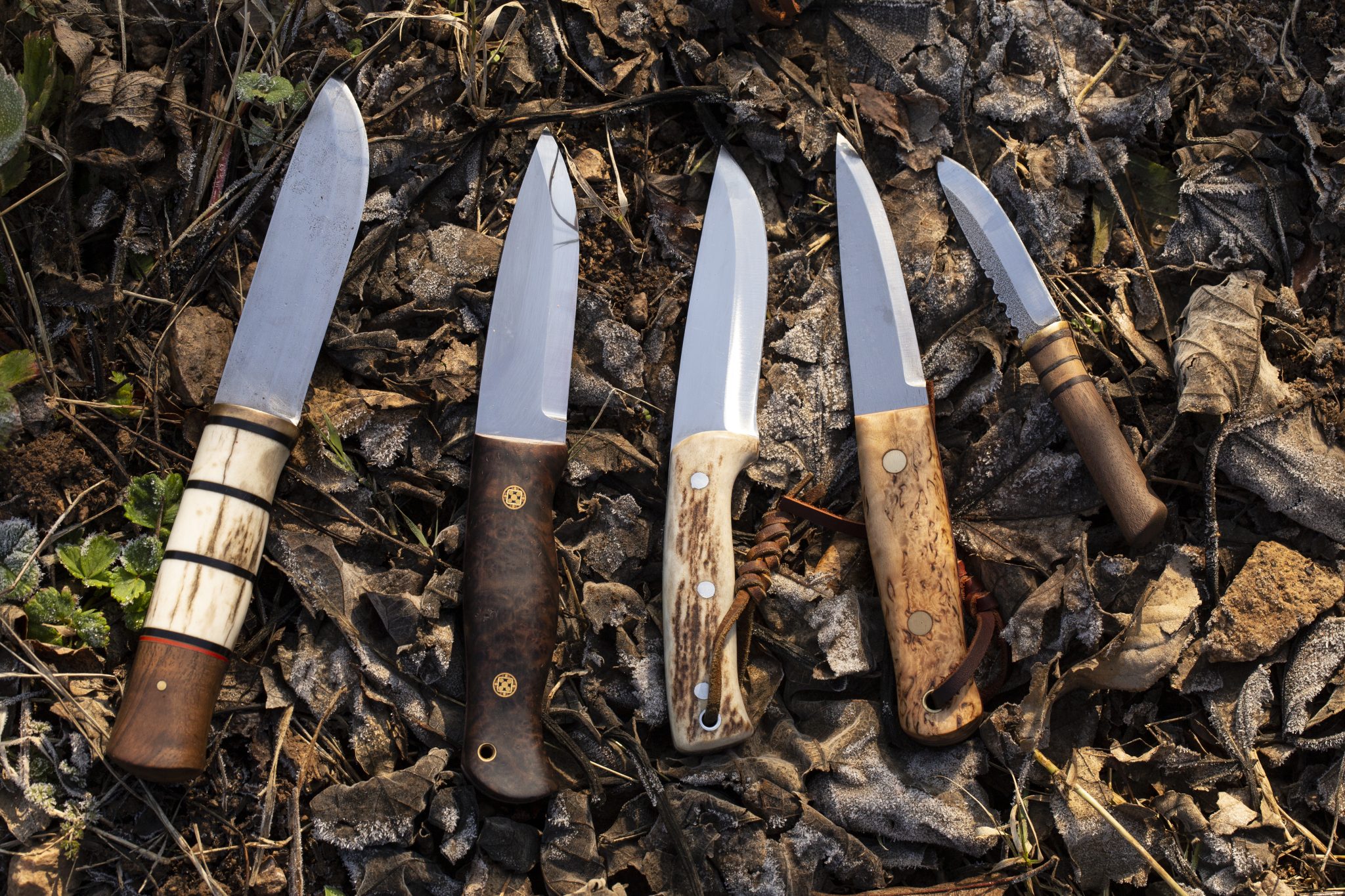Win CENS ProFlex DX5 earplugs worth £1,149 – enter here
How to use an airgun for rat control
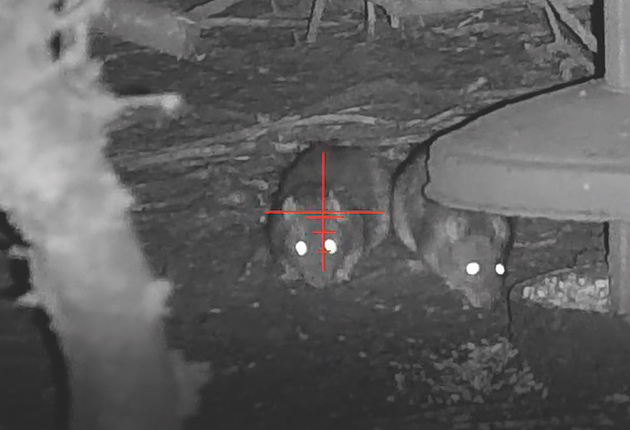 Mat’s first scan through his night vision scope revealed two rats scavenging grain around the feeder
Mat’s first scan through his night vision scope revealed two rats scavenging grain around the feeder
Air rifles are useful pieces of equipment for rat control. Use a backstop sensibly and effectively (usually a concrete wall in a farmyard) and an airgun for rat control can be safely and effectively used in places where you wouldn’t dream of firing a shotgun or rimfire rifle. In fact, although the limited power of legal limit (sub-12ft/lb) air rifles is often regarded as a drawback, lower power levels and the consequent reduction in risk of ricochet can often be a huge advantage — especially when carrying out pest control in confined spaces or close to livestock. (Read more on pest control with an airgun.)
Rats breed all year long so farms can be quickly overrun. Whilst the farmer will have measures in place – usually poison – an airgunner can be a useful addition to the rat control campaign. A productive night’s shooting can yield 40 or 50 rats — often many more — so an airgun shooter’s contribution can be major. Numbers on farms tend to peak during the colder months of the year when natural food becomes scarce. (Read our list of the best airgun pellets here, which offers some useful advice on which ammunition to choose.)

Shooting with the support of sticks allows you to take full advantage of any chances that may come your way. When you’re ratting, you have to grab your opportunity fast.
Which airgun should you use for ratting?
If you’re choosing an airgun specifically for ratting, go for one with compact proportions, so you can quickly swing on aim without fear of bashing the barrel when shooting in a confined space. A magazine-fed loading system is also a help when shooting at night, as it will save you the hassle of blindly fumbling into the breech when rats are scurrying about in front of you.
Much fuss is made about the supposed advantage of using the larger .22 and .25 airgun calibres when shooting rats at close range, but I actually prefer to use the .177 and limit myself to head shots. This isn’t too challenging when you consider that you’ll generally be shooting at ranges of between 12m and 20m.
Which airgun for rat control?
Some options to consider:
22 calibre BSA R-10 Mk2
Brocock BRK Ghost Carbine
Brocock BRK Ranger XR
FX Impact M3
FX Dreamline
When and where to go out ratting
Rats start to become active at dusk. So if you’re having an evening session of using an airgun for rat control, arrive at the location an hour or beforehand and take some time to look for the runs they use to travel between their nests and the places where they feed — maybe at a silage clamp, feed store or among cattle that are inside for the winter.
Find yourself a place to sit and wait about 12m or 15m away, then set out your baits where you can easily see them and take safe, unobstructed shots. Baits can be placed outside ratholes if you can’t locate the runs, although the occupants can become spooked and refuse to venture out. I usually transport my kit — which includes bait, torch, headlamp and stout gloves — in a small backpack that incorporates a fold-up stool. Apart from it being useful for carrying my ratting essentials, this also means I have a stable place to sit and shoot from if I can’t find a convenient stack of hay bales, feed sacks or pallets.

Find yourself a place to sit and wait
Where you will find rats
These places attract rats:
- Heaps of rubble
- Dilapidated sheds,
- Stacks of logs
- Piles of scrap metal
- Log stacks
- Animal feed and grain
- Around hen houses
If you have permission to shoot on a farmyard or on ground that’s managed for pheasant shooting, the chances are there will be rats. Rats are smart and will search out easy feeding opportunities and it doesn’t take them long to find them. On a shoot, you will usually discover rats in areas close to feed hoppers especially if close to a bank or log pile. (Read how to keep predators out of your pheasant pens.)
Rats will sniff out a meal and quickly set up home close to places where they can steal food from troughs and silage clamps. Grain stores are a favourite, and rats can cause major problems when they find their way into places where foodstuffs are stored.
Treat rats with respect
Rats should be treated with the same respect in terms of swift despatch that a hunter should try to give any quarry. Rats are surprisingly hardy creatures and I try to take them out with headshots — this sounds like a tall order until you consider that farmyard rat shooting is rarely done at ranges much beyond 15m. With practice, most people should be able to group shots within a 25mm circle when using a pre-charged airgun to shoot at 15m from a stable sitting position. The tricky thing, however, is getting rats to keep still long enough for you to get a steady bead on their head. So the best answer is to get them busy with some bait. (You’ll find our list of the best chronographs for air rifles here.)
The best bait for rats
One of the toughest parts of using an airgun for rat control is getting a telling shot at these fidgety rodents, but it’s much more easily done if you use some bait. My favourite approach is to target rats either as they emerge from their burrows or as they make their way along their runs between their nesting site and wherever they’re feeding. Place a tempting offering where they can’t miss it, and they’ll probably stop to investigate. Liquidised cat food is one of my top rat baits
Rats can’t resist piles of this smelly, fishy sludge, and the fact that it has been turned into a soup means they have to pause and lap it up if they want to get a bellyful.
I’ve also been experimenting with the fishmeal pellets you can buy from angling shops, too; they’re clean and dry, rats seem to like them and, if you buy the really tiny pellets, they have to stop to get a decent mouthful which gives you time to get them on the cross-hairs. (Read more of Mat’s tips on baits to use for ratting here.)
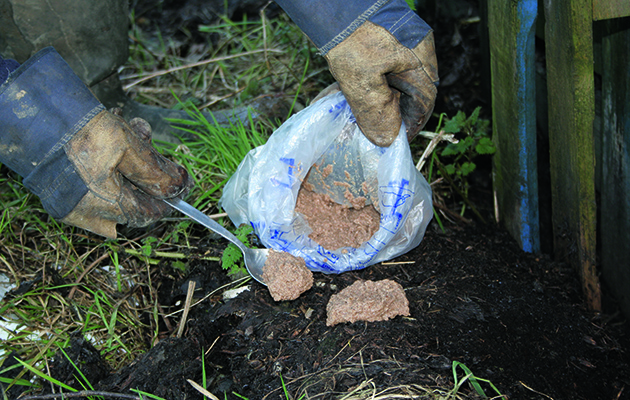
It may be messy but liquidised cat food is great for keeping fidgety rats exactly where you want them
Lamps
Gun lamps designed for airgun shooting seem to be getting more and more powerful, and often boast far more candlepower than you’ll ever need for ratting. Make sure you opt for one with variable power so that you can wind it down to a very soft glow. Rats are often suspicious of lamplight, so the last thing you want is a beam that will light up the hills 400m away. (Read lamping rats and night vision rat hunting.)
Using a scope-mounted lamp
My advice for after-dark shooting is “keep it simple” — so I use a conventional scope-mounted lamp usually.
Clip a lamp to the top of your scope and you’ve got light wherever you point the gun. Bearing in mind the close ranges you’ll be shooting at, there’s no need to splash out on a super-powerful lamp. In fact, lamplight that is dimmed down with a red filter is much less likely to spook rats than a dazzling beam.
While I acknowledge that hefty .22 and .25 pellets have more knockdown power, they also have a significantly curved trajectory when fired from a legal limit (sub-12ft/lb) airgun. Range estimation can be tricky when you’re shooting by lamplight or with night vision, and I’ve often found myself missing over the top or underneath my target after misjudging the range by a few metres. A faster, lighter .177 pellet has a much flatter trajectory, which makes it far more forgiving if you don’t get your hold-over or hold-under exactly right. consequently, it makes it much easier to land a head shot right on target — and if you hit a rat squarely in the skull, you’re going to achieve a clean kill whatever calibre you’re using.
When it comes to choosing a telescopic sight, I like a model with variable magnification — usually with a range of 3-9x or 4-16x. I tend to wind down to 5x or 6x at night. The lower magnification helps to improve light transmission and results in a wider field of view, which makes it easier to spot rats while scanning through the scope. (We’ve listed our best airgun scopes here.)
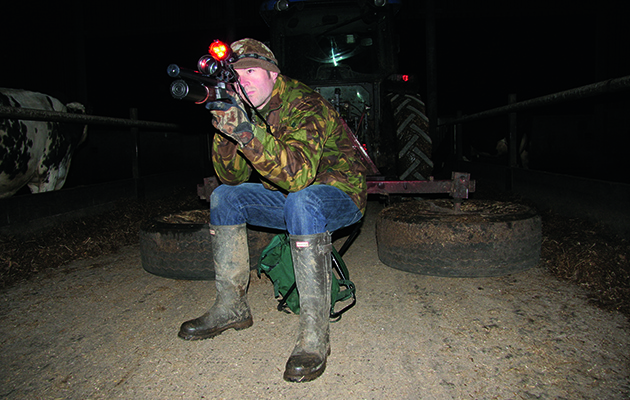
Rats are most active from twilight until a few hours after nightfall, so Mat uses his Tracer Tri-Star lamp and Nite Site NS-50 night vision unit
Sitting comfortably
A stable, comfortable seat is essential. I use a cheap little backpack stool; it provides a steady shooting platform and room to stash a torch, hat, gloves and other night shooting essentials — it’s also reassuring to know that you’re well off the ground when there are rats scuttling about.
Though you can shoot plenty of rats by wandering around the farm and picking them off as you go, you can often shoot a lot more by setting up an ambush in a place where they’re particularly active. You can give them a good pasting before moving on to another spot.
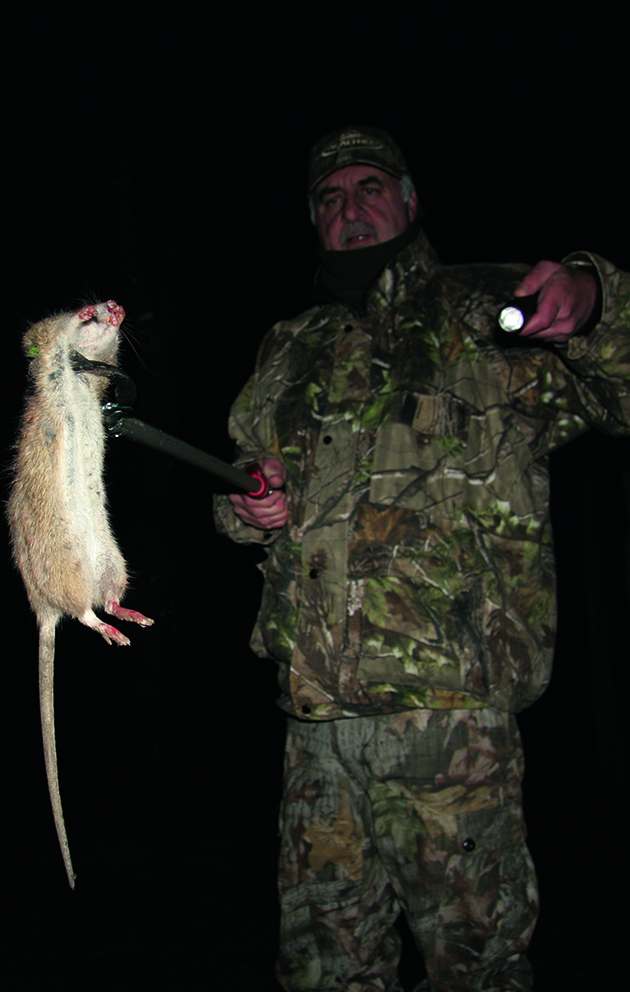
A litter grabber means you won’t have to run the risk of touching rats, which harbour diseases
Safety
Farms can be dangerous places, so make sure you get to know the location in daylight and will be aware of any potential hazards you might miss if you go ratting at night.
Rats can also be dangerous. They are known carriers of some nasty, potentially fatal diseases, including Weil’s disease. Infection can be picked up from contact with their urine, which could be literally anywhere. Never take foot and drink on a ratting trip.
Never handle rats with bare hands – that’s why you need stout gloves in your backpack. And if you’re clearing up the vermin after lamping rats with airguns, move them with a shovel or spade – and wear your gloves throughout. (Read our list of the best kit for airgunning.)
It’s also a good idea to carry a litter grabber so that you can keep your hands well away from rats when clearing up after a productive shoot, though you should be able to find a shovel on most farms.
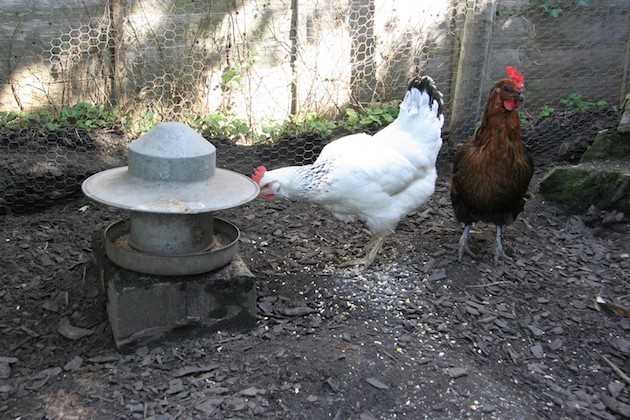
The rats had been attracted by the feed Mat puts out for his laying hens.
Dealing with rats by a hen house
Rats love grain so a hen house and hens are like magnets for the rodents.
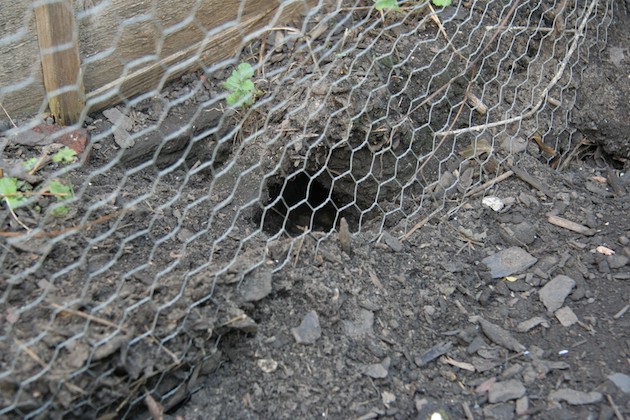
Holes along the edge of a chicken run are a sure sign of intruding rats.
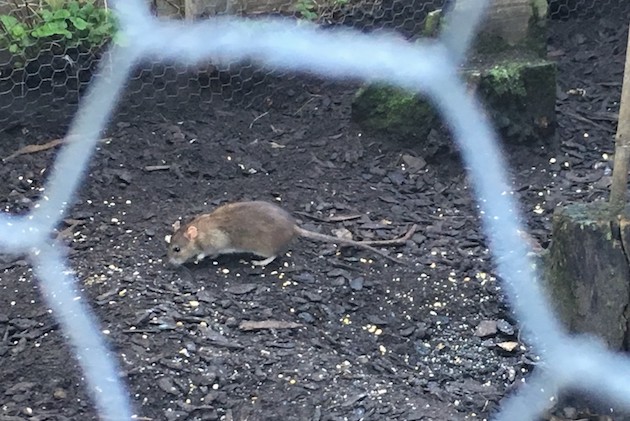
This cocky customer hung around long enough for Mat to snap it with his iPhone.
We had rat problems around our hen house so I made a plan.
Over the next couple of mornings, I placed a small heap of cut maize in the chicken run and carried on with other jobs for half an hour or so before letting the hens out. Even on the first morning, the corn had been snaffled by the time I returned. Rather than trying to thread shots through the wire mesh that surrounds the run, I was going to shoot through the open door — before letting the hens out of their coop — and I intended to use my maize offering to persuade the rats to venture out to where I could get clear shots at them.
I had intended to continue with the pre-baiting ritual for the best part of a week to give the rats time to really grow in confidence, but impatience eventually got the better of me. To be fair, the rodents weren’t exactly shy and, as I hadn’t seen more than two out at once, I didn’t want to give them time to multiply.
Because I was only going to be taking shots at about 15m, I opted for simplicity over sophistication and took my ever-reliable Weihrauch HW 95K from the cabinet. The little .177 break-barrel may not be fancy but it is extremely accurate and has accounted for a quite a few rats over the years. I slipped a handful of pellets into my pocket, grabbed my backpack stool in readiness for the mini stake-out and made my way up the garden.
The chicken run door had been left open all night in order to get the rats accustomed to the new arrangement, so all I had to do was dish out a little heap of cut maize and sit back to await the arrival of the diners.
There was a plump rat on the bait pile before I’d even set up my seat. The greedy rodent continued to feed while I made myself comfortable on the stool and loaded up, but the clunk of the closing barrel sent it dashing for cover. I needn’t have worried, though, as a pair of rats ventured back out to feed no more than two minutes later.
Shooting from a sitting position, and at very close range, the shot was a mere formality and I toppled the larger of the rats with a smack to the head. Its mate darted off at the sound of the impacting pellet but I had a feeling it would soon be back for more.
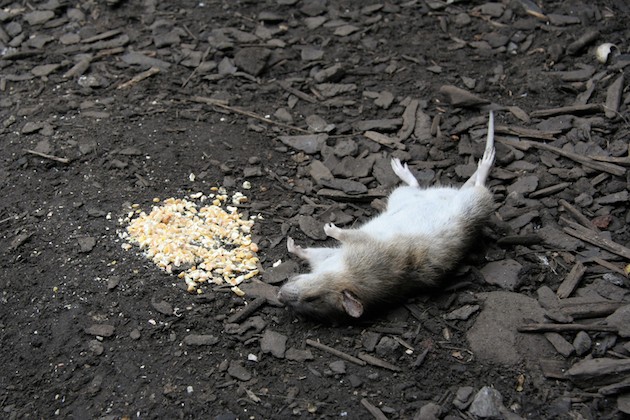
The cut maize offering worked a treat, luring the first rat out for a clear shot.
Head shot
I was starting to regret not taking a mug of tea with me when a rat — presumably the one that had scuttled off a few minutes earlier — poked its head out of a hole at the back of the run. I settled the cross-hairs just behind its eye and squeezed the trigger, ending its feed-stealing days with eight grains of lead to the head.
After a hearty breakfast, I went back out and stamped rocks into the holes the rats were using to access the run in an effort to discourage others from creeping in for a feed. I’m pleased to say there has been no sign of unwanted visitors over the past couple of days, but you can never drop your guard when it comes to keeping rats away from poultry.
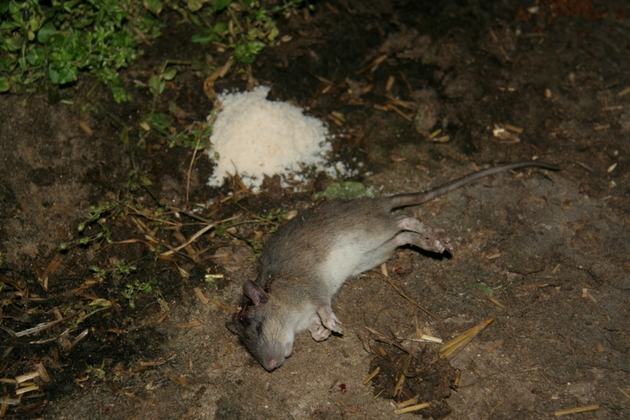
This young rat lingered too long on one of Mat’s breadcrumb piles and paid the price
More on night vision for ratting
As previously mentioned, rats often become suspicious of lamplight, especially after a few nights of hard shooting. With night-vision kit getting more and more affordable, this high-tech gear is a realistic alternative, and enables you to use an airgun for rat control without having to use conventional illumination.
The Yukon Photon night-vision scope has a loyal following among airgun shooters. I’ve also made some huge tallies using the NiteSite Viper and the Night Master Atom. These two digital add-ons connect to your normal telescopic sight, using a camera to see through it and converting the sight picture into a digital image. I prefer to use add-ons rather than dedicated night-vision gear because you can use all the usual aim points on your scope without having to re-zero, and you don’t need a separate airgun to dedicate to night-vision shooting. (Read more on scopes for air rifles.)
More on optics
Q: I would like to buy a digital infrared night vision scope for after-dark ratting with my air rifle. Can these optics also be used for shooting grey squirrels in daylight?
A: Apart from producing an infrared image by night, most modern digital optics also produce a full-colour image by day. The quality of daytime viewing has reached a point where it’s getting close to that of conventional glass optics, and image lag is barely noticeable on most models. This means that, apart from being very handy for zeroing, the daytime mode is well up to the task of shooting pests in daylight.
Which pellet?
Q: I am looking for a pellet that will deliver plenty of shock at close range when targeting rats around the farmyard. Some people have told me to use hollowpoint pellets that open up on impact, while others say they are inaccurate. What would you recommend with my airgun for rat control?
A: My recommendation is to use a quality roundhead pellet that produces good accuracy with your airgun and focus on hitting the right spot, rather than worrying about what the pellet does when it gets there. By and large, hollowpoint pellets don’t tend to be accurate and certainly don’t mushroom as much as we are led to believe when fired from a sub-12ft/lb airgun. (Read our list of the best airgun pellets.)
There does seem to be an unlikely exception to the rule in the shape of the JSB Predator Polymag. I assumed that the dum-dum design and polymer tips were probably only a gimmick, but my Weihrauch HW100 shoots them accurately out to about 20m and they do open up more than typical hollowpoint airgun ammunition. I have been using them to clobber farmyard rats and, while I can’t guarantee your airgun will shoot accurately with them, they are certainly worth a try.
This article was originally published in 2016 and has been updated.
Related Articles
Get the latest news delivered direct to your door
Subscribe to Shooting Times & Country
Discover the ultimate companion for field sports enthusiasts with Shooting Times & Country Magazine, the UK’s leading weekly publication that has been at the forefront of shooting culture since 1882. Subscribers gain access to expert tips, comprehensive gear reviews, seasonal advice and a vibrant community of like-minded shooters.
Save on shop price when you subscribe with weekly issues featuring in-depth articles on gundog training, exclusive member offers and access to the digital back issue library. A Shooting Times & Country subscription is more than a magazine, don’t just read about the countryside; immerse yourself in its most authoritative and engaging publication.



